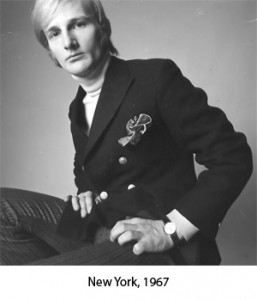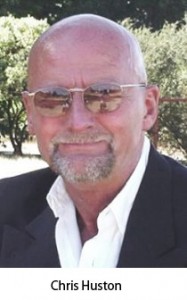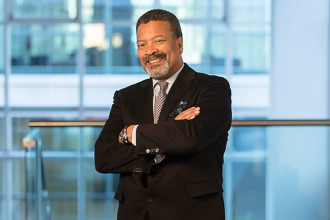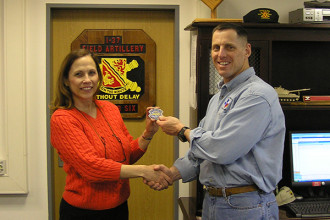AV People: Chris Huston of Rives Audio
By Molly Stillman
The year was 1963. Chris Huston, the lead guitarist for The Undertakers, voted the third-best rock and roll group in Liverpool at the time, was hanging out with the rest of his band near the back of the Cavern Club where they were having a lunchtime playing session. They hanging out with their friends George, Paul and John from a little better-known group called the Beatles.
Brian Epstein, the manager for the Beatles at the time, came down the stairs and interrupted the boys’ conversation. Epstein pointed at Chris and a couple of bandmates and said, “I’d like to see a couple of you boys in my office later,” and walked away.
Chris said, “What was that about?”
John looked at him and said, “I think he wants to manage you guys.”
“But we already have Ralph Webster — we’ve got plenty of places to play,” Chris retorted.
The next thing he knew, John smiled at him said, “Good job! He ain’t done nothing for us, yet,” threw out an expletive or two, and walked away. And that’s the day The Undertakers turned down Epstein as their manager and Chris was cursed at by John Lennon.
Today Chris Huston is the senior acoustical engineer for Rives Audio, but he’s no stranger to the industry. Huston is the man you want to listen to for hours. I could write a book on the life of Chris Huston.
It was a Tuesday morning when I hopped on Skype to have my interview with Chris. I knew he’d been a performer for years. I knew that he was well versed in the audio segment of the industry. I knew that Chris was really a pioneer with audio production and engineering. I was prepared.
What I wasn’t prepared for what his level of enthusiasm and passion for the industry, and the incredible experiences that led him to where he is today.
Before moving to the United States in 1965, Chris spent a good number of years playing lead guitar for a few different bands in the Liverpool Merseybeat music scene before finding his niche with leading British beat group, The Undertakers. The Undertakers opened for groups like Gerry & the Pacemakers and The Beatles, and sometimes those groups would even open for The Undertakers.
“The Beatles borrowed our amps quite a few times,” said Huston. “I mean, we had the better amps, and they knew it.”
After moving to the U.S. in 1965 to do a tour and record an album with the band, Chris realized he didn’t want to play anymore.
 “I wasn’t a guitar king,” Chris said. “I was adequate, but I had ideas. I saw the potential in the recording industry. Whenever I worked with a group they’d be like, ‘Where should we setup? What should we do?’ and I’d tell them to set up like they’re rehearsing — that’s a good place to start. I was making it easier on the groups and making them feel comfortable, I realized we were no longer taking the creative energy out. Unfortunately, that’s what happened to us [The Undertakers] when we recorded for PYE records. We were told where to stand and the tone and volume of our amplifiers was adjusted by the recording engineers.”
“I wasn’t a guitar king,” Chris said. “I was adequate, but I had ideas. I saw the potential in the recording industry. Whenever I worked with a group they’d be like, ‘Where should we setup? What should we do?’ and I’d tell them to set up like they’re rehearsing — that’s a good place to start. I was making it easier on the groups and making them feel comfortable, I realized we were no longer taking the creative energy out. Unfortunately, that’s what happened to us [The Undertakers] when we recorded for PYE records. We were told where to stand and the tone and volume of our amplifiers was adjusted by the recording engineers.”
This was all before multi-track recording.
And Chris quickly realized that if he wanted to be a decent producer, he needed to get a working understanding of engineering — how records were made, and more than just his own understanding. Chris needed to learn the ins and outs of engineering.
So he stayed at the Pye Records studio and learned to become a producer. He slept on the couch in the back office at the studio. He mopped floors and acted as a second engineer and he started to bring groups in.
Back then, records were made using a 4-track recorder. The band would play live in the studio and each thing would go on four specific tracks.
For example a typical track assignment might be:
Track One: Rhythm
Track Three: Strings and Horns
Tracks Two or Four: Vocals and any overdubs as you worked between the tracks
 So, using the ’ping-pong’ method you would be able to record on one track, then ‘bounce’ recording that to another track while adding any additional instruments and/or vocals — you just couldn’t ping pong between adjacent tracks or else you’d get feedback. So, Tracks One and Three, Tracks Two and Four, or Tracks One and Four could all be used for ping ponging, but never Track Two and Three, which were adjacent. Many great records were made in this manner, including some of the Beatles albums.
So, using the ’ping-pong’ method you would be able to record on one track, then ‘bounce’ recording that to another track while adding any additional instruments and/or vocals — you just couldn’t ping pong between adjacent tracks or else you’d get feedback. So, Tracks One and Three, Tracks Two and Four, or Tracks One and Four could all be used for ping ponging, but never Track Two and Three, which were adjacent. Many great records were made in this manner, including some of the Beatles albums.
Then, in 1967, 8-track came along and the ability to break things up more became available. Then, 16-track and 24-track recording machines followed quickly.
But as Chris learned more about engineering and the advancement of recording, he learned things were taking a turn for the worse.
“In an effort to further isolate instruments and vocals, they had to change the beautiful acoustics of the rooms,” Chris said. “They took the LIVENESS out of the rooms — they killed those beautiful live acoustics in order to improve the ability to separate tracks in a multi-track machine. Before, you’d have two or three mics on a drumset. Then suddenly, you found yourself with 10 to 12 mics or more on a drumset.
“Back then you were documenting a performance. Today, you’re creating a performance.”
And despite this “turn for the worse,” Chris has had the pleasure of working with artists like Led Zeppelin; The Who; Benny King and the Drifters; Patti LaBelle and the Bluebells; Blood, Sweat & Tears; James Brown; War; Sweetwater and many other great musicians and singers. Chris also has a Grammy to his name for his work on War’s “The World is a Ghetto.”
To this day, Chris has taken his love of producing and engineering and transferred that knowledge and experience that to his work at Rives. He now designs home theaters, high-end listening rooms and recording studios, both commercially and in homes.
He really does love what he does. But he still remembers those days in Liverpool as one of the leading bands on the Merseybeat music scene.
Today he also still gets asked for his autograph. I kind of want his autograph. The truth is, I won’t ever be able to do the coolness of Chris Huston justice.
Molly Stillman is the director of marketing and new business development for rAVe [Publications]. Reach her at molly@ravepubs.com
Do you know someone in the industry with an interesting story that should be featured in our monthly column? Email Molly and let her know






